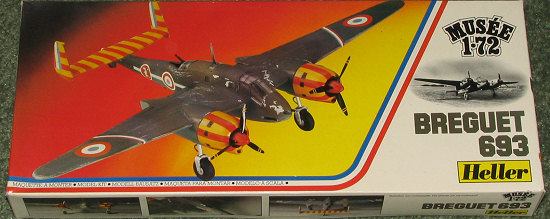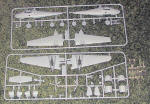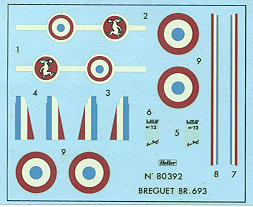
| KIT: | Heller 1/72 Breguet 693 |
| KIT #: | 80392 |
| PRICE: | $10.00 MSRP when last issued |
| DECALS: | One option |
| REVIEWER: | Scott Van Aken |
| NOTES: | Reissue from early 1990s |

| HISTORY |
The Potez 630 and its derivatives were a family of multi-role twin-engine aircraft developed for the Armée de l'Air in the late 1930s. The design was a contemporary of the British Bristol Blenheim and the German Messerschmitt Bf 110.
The Breguet 690 series of twin-engine multi-role aircraft were attractive, high-performance, modern planes which, like many of France's aircraft in 1940, were simply too late to make a difference.
The Breguet had begun life in 1934 as Breguet's response to the same, quite far sighted strategic fighter specification that resulted in the eventual winner, the Potez 630. Both were attractive twin-engine monoplanes with twin tailplanes, powered by Hispano-Suiza 14AB radial engines of modern design and, for the time, good performance.
Although the Breguet lost out in the competition for a strategic fighter, after considerable debate and delay the French Air Staff decided to acquire modern attack aircraft. Engineless for nearly a year, the prototype displayed such promise that 100 two-seat attack bomber versions known as the Breguet 691 AB2 were ordered in mid 1938, an order soon doubled. The production model had a 20 mm cannon and a pair of light machine guns firing forward, could carry eight 50 kg (110 lb) bombs, and also packed two further light machine guns firing rearwards.
Breguet established an assembly line with remarkable speed: the first production aircraft flew less than a year after being ordered and was in service before the end of 1939.
As with the Potez 630, the Bre 691 was beset with engine difficulties. Hispano-Suiza had decided to concentrate on its V12 liquid cooled engines and the 14AB engine was unreliable. The French authorities decided to order a new version Bre 693 powered by Gnome-Rhône 14M radials. Apart from the changed engines, which were of slightly smaller diameter, the two types were virtually identical. Orders for the Bre 691 were switched to the new type and more than 200 of the latter had been completed by the time of France's defeat.
Late production versions of the Bre 693 introduced a pair of additional light machine guns in the tail of each engine nacelle. Belgium ordered 32 license built copies but none were completed before the Belgian collapse.
The little Breguets were popular with their crews, although the unreliable engines in the Bre 691 caused headaches and undercarriage failures proved troublesome. The aircraft was well designed, easy to maintain, pleasant to fly and could fly at 480 km/h at 4,000 metres (13,000 feet). The type's sturdy construction was frequently demonstrated and the armament was effective. Unfortunately, in the haste to get the Bre 693 into production the opportunity was lost to specify a low-level version of the Gnome-Rhône 14M, but in time no doubt this would have been remedied.
Crews were still working up their new machines and developing tactics when the Germans struck. The loss rate was almost 10% in the six weeks of the blitzkrieg. The Vichy air force kept the Breguet in service in one attack group; after the Germans occupied all of France in late 1942 the survivors were transferred to Italy for use as operational trainer aircraft.
Like the Bloch 175 light bomber and the LeO 451 and Amiot 351 medium bombers, the Breguet 693 showed that French designers were as good as any in the world. Unfortunately, French rearmament began two full years later than that in Britain and all of these fine aircraft were simply not available in sufficient numbers to make a difference in 1940.
| THE KIT |
 Molded
in their standard grey plastic, this is one of Heller's early kits. It has
nicely raised detailing, and unlike the earlier previewed Potez 63-11, does not
suffer from any mold glitches, being free of sink areas, ejector pin marks, or
flash. As well maintained as the molds have been, this has to be a very early
kit. The wheels are like those found on toys with no detail at all. There are no
engine faces, only blanking plates and there is no interior, not even a
rudimentary cockpit, though there is a rear gun.
Molded
in their standard grey plastic, this is one of Heller's early kits. It has
nicely raised detailing, and unlike the earlier previewed Potez 63-11, does not
suffer from any mold glitches, being free of sink areas, ejector pin marks, or
flash. As well maintained as the molds have been, this has to be a very early
kit. The wheels are like those found on toys with no detail at all. There are no
engine faces, only blanking plates and there is no interior, not even a
rudimentary cockpit, though there is a rear gun.
Landing gear are built up prior to
wing assembly and then simply slotted into the small opening. Wings have large
mounting tabs so it should be quite a sturdy construct. Single piece horizontal
stab and fin/rudders are provided to ease construction. Clear bits are well
done, but thick, which is fine considering there isn't any cockpit to see. The
only area I can see that might cause concern is that the engine fronts are glued
on after the landing gear are installed. This may make any filler applications
troublesome.
The instructions are 9 construction steps with any color information provided within. There is an addendum sheet that provides color names and Humbrol color cross reference. Since this isn't an ancient boxing, the decals appear to be quite useable and are semi-matte. Markings are for the aircraft on the box top from GBA 1/51 of the Vichy Air Force in 1941. The yellow and red stripes will have to be painted on, but will make for a very colorful aircraft.
Instructions are in French, though an English addendum sheet is provided. It is typical Heller with an exploded view showing all the parts and their location. Markings are provided for one aircraft, but in my kit, these were so badly yellowed as to be pretty much unusable. The roundels are also off register. They are for a single aircraft of an unknown unit. If anyone can help out with usable markings for this plane, that would be much appreciated.
| CONCLUSIONS |
In all, a very nice looking aircraft and a rather simple appearing kit. I'm not sure if anyone else has done one of these, but if you are a fan of WWII French aircraft, it deserves to be in your collection.
| REFERENCES |
Wikipedia
December 2006 If you would like your product reviewed fairly and quickly by a
site that has over 325,000 visitors a month, please
contact
me or see other details in the
Note to
Contributors.